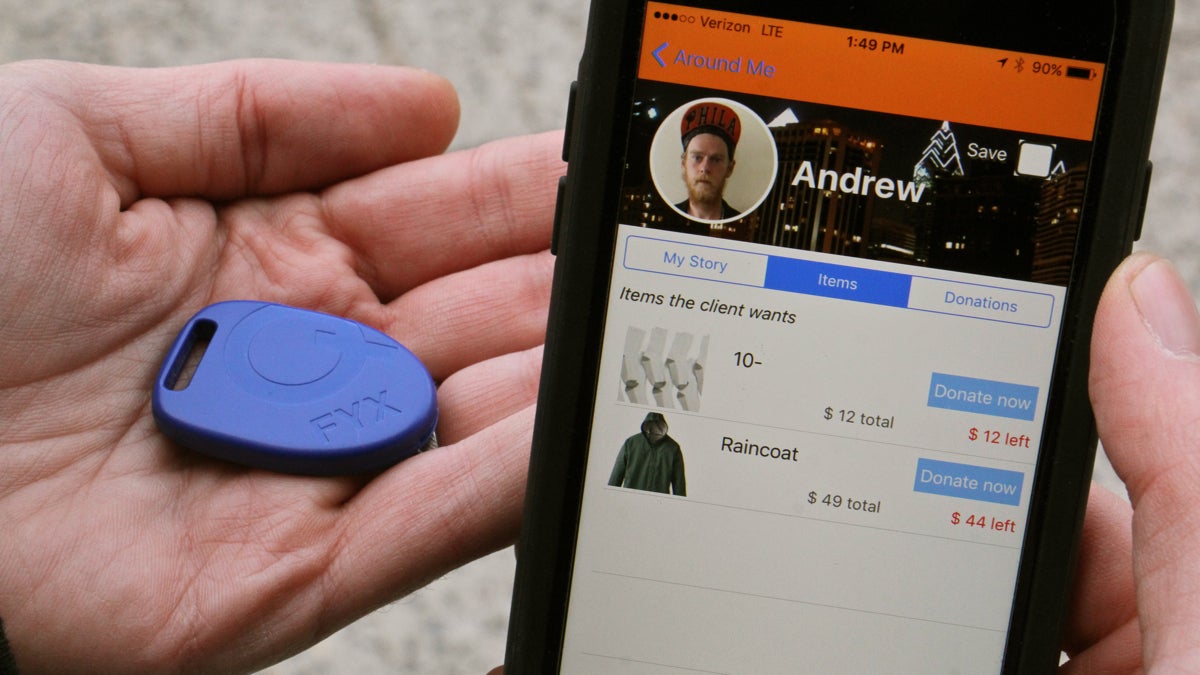StreetChange aims to improve chance interactions with the needy
Listen
A new app alerts users when a homeless person with a wish list is nearby. A beacon (left) carried by the homeless person has a radius of up to 150 feet. (Emma Lee/WHYY)
If you live or work in Philadelphia, you’ve probably wrestled with these options when crossing paths with a panhandler. You can stop and hand over some change — or keep on walking, maybe because you’re uncomfortable not knowing how it will be spent.
Enter Andrew Siegel and Dan Treglia, a pair of researchers at the University of Pennsylvania who started thinking about how to help settle that internal debate and ended up securing a modest grant to develop a free mobile app they expect to officially launch this winter.
Instead of wondering where your dollar is going when you give to a stranger, StreetChange allows users to pick from a list of items — maybe a winter coat or a pair of shoes — requested by a homeless person vetted by outreach workers with the Mental Health Association of Southeastern Pennsylvania.
It all happens in real-time and on the fly, thanks to PayPal and Bluetooth technology.
“This program would fail if we were to require prospective donors to a take a significant amount of time out of their commutes to work or their walks around Philadelphia to engage and make donations,” said Siegel, who is also a psychiatrist.
If they agree to have a profile on the app, association staffers hand enrollees what’s known as a Bluetooth ibeacon — a tear-shaped piece of plastic not much bigger than a pair of quarters side-by-side. It can be attached to a key chain or thrown in a pocket.
The beacon sends out a signal that alerts the app user that an enrollee is nearby, what items they’ve requested, and how much money is needed to buy those items. The user can then choose to donate at least a $1 toward that person’s wish list.
Both parties are notified when the item is crowdfunded, but there’s no Big-Brother style map tracking the whereabouts of the homeless participants.
Darnell was one of about 40 homeless people who was part of a pilot version of StreetChange this spring. He said the app is perfect match for someone like him. He doesn’t like to ask for money on the street.
“I still got pride in myself, you know. And plus, I don’t like nobody telling me no,” said Darnell, who asked that his last name be withheld.
The app paid for some basic toiletries — toothpaste and a bottle of mouthwash. A hat and a scarf too.
“It allowed me to not to run in somebody’s store and take their stuff. Because when you’re out here in the street, people do real stupid stuff,” said Darnell. “And when you do stupid stuff you get caught and you got to pay the consequence.”
Enrollees can only collect at one of the Mental Health Association’s drop-in centers.
A small step toward getting back on track
That’s on purpose. In addition to fulfilling short-term needs, Treglia and Siegel think StreetChange can be a vehicle for helping the homeless get back on their feet — what can often feel like an insurmountable challenge.
The hope is that offering the opportunity to get a new winter coat or a pair of shoes can be the icebreaker that gets enrollees working on long-term goals with a case manager.
“They might say, ‘Hey, maybe you’re not ready to get into that apartment right now, but hey we can help you get you the things you need to survive for the moment.’ That can create a connection that we can build on in future conversations to eventually move someone towards better health care and housing opportunities,” said Treglia, who has studied homelessness for the better part of a decade.
Michael Brody, president of the Mental Health Association, said a lot of homeless people don’t necessarily trust organizations created to help them. They’ve been burned too many times and feel like the odds are stacked against them.
“Sometimes by entering the system, they’ve been forced to do things against their will that they didn’t want to do. And so, there’s this reluctance, on the part of some people, to take that step again,” said Brody. “This is another way to build a relationship with them, to bridge a reason to be talking with each other and spending some time with each other.”
During the pilot phase this spring, StreetChange enrolled roughly 40 homeless people. Siegel, the Penn researcher, said no one declined to participate because they were concerned about privacy or carrying the Bluetooth beacon.
It’s unclear how many homeless people sleep on the street each night in Philadelphia. Every year, volunteers perform what’s called a point-in-time count. But it’s an estimate at best.
The city had 705 “unsheltered homeless” in 2016. Several thousand more are said to have experienced homelessness at some point during the year.
It’s also unclear whether taking some of the mystery out of charitable giving on the street will actually get more people to flex their philanthropic muscles and, in turn, decrease the number of street homeless in Philadelphia.
Treglia and Siegel figure it’s worth trying nonetheless.
“It’s an opportunity to engage people who are at risk for longer homelessness and worse physical and mental health problems,” said Treglia.
“It’s still really a hypothesis that needs testing,” adds Siegel.
WHYY is your source for fact-based, in-depth journalism and information. As a nonprofit organization, we rely on financial support from readers like you. Please give today.





